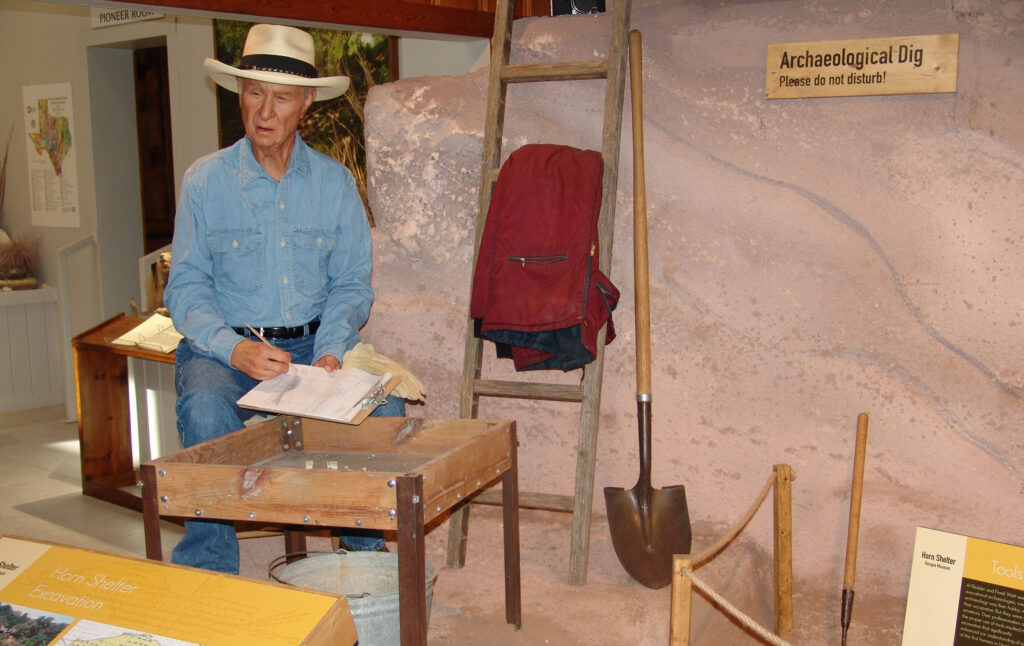
A lifelike mannequin of Al Redder greet visitors at the Horn Shelter exhibit. Photo courtesy Bosque Museum.
When you walk into the Horn Shelter exhibit at the Bosque Museum in Clifton, you’re greeted by an actor-voiced mannequin that is so lifelike, it’s eerie. This is Al Redder, one of the avocational archeologists who discovered the museum’s main attraction: a man who died 11,700 years ago and was buried near the Brazos River between Waco and Lake Whitney. Redder and his team found and reconstructed the skull that provided the specifications for the bronze bust of the man that is displayed in the exhibit and attracts visitors from all over the world to this small art town located about 30 miles northeast of Waco.
Today, the museum’s new Horn Shelter exhibit looks nothing like the one that has been the museum’s centerpiece since debuting in 2005. At a cost of $200,000, Museum Arts of Dallas recently redesigned the exhibit to be fully interactive, allowing visitors to experience the process of discovery the archeologists went through instead of just seeing what they discovered—a burial site unearthed in 1970 that dates to the Paleoamericans, the founding human population of North America.
“The original exhibit deified the archeologists and their great achievements, but had little about how they did it,” says Erin Shields, director of the Bosque Museum.
There have been only 15 Paleoamerican burial sites discovered in North America, and Horn Shelter, a limestone overhang that made it a favorite camping site since the end of the Ice Age, is especially noteworthy in that it’s the only one with two skeletons. DNA testing is ongoing to determine if the adult male and the female child buried together were related.
The first Horn Shelter exhibit told visitors that the man, estimated to have lived about 40 years, was buried with a tool-making kit. After further research and study, it’s believed he was a shaman buried with a “medicine bundle” and spiritual offerings, including badger claws, hawk talons, turtle shells, and deer antlers. A sharpened bone needle found with red pigment may have been used in tattooing.
Because the skeletal remains and the artifacts are kept at the Smithsonian or studied by Harvard scientists, the displayed material was all replicated from the original. In the new exhibit, visitors get to see actual tools and layers of sediment that tell the history. Redder, however, has yet to visit the exhibit. Now 95 and living in Waco, he has not been well enough to travel to Clifton.
The museum unveiled the new exhibit in November 2020 to commemorate the 50th anniversary of the Horn Shelter discovery. The display occupies a winding walkway inside a faux hanging rock formation, with movements triggering voices that guide you as you walk through the science of excavation and artifact analysis. It’s a perfect place for school field trips and early human history buffs. COVID-19 precautions have kept group showings to a minimum so far, but anybody can go on their own.
Even if it didn’t boast over 11,700 years of history, the Bosque Museum is one of the finest county museums in Texas. It was built in 1954 to house the massive collection of artifacts, memorabilia, and handmade furnishings of Norwegian settler Jacob Olson, whose childhood home, a 1867 log cabin built by his father, Joseph Olson, sits at the museum’s entrance. There’s also a gallery of fine art paintings set in Bosque County.
The Bosque Museum is open Thursday through Saturday from 10 a.m. to 5 p.m., and Sundays from noon to 5 p.m.








